This week, we're diving into the science of clean water, finding out why rivers and ponds are essential for wildlife, and how alien invaders are colonising our waterways. Plus, how a diet of glycerol makes yeast live longer, how microbes in mosquitoes can block malaria and how planting trees could reduce your electricity bills. We hear about the European Space Agency's Planck and Herschel missions to study the formation of galaxies and the fate of the universe, and in Kitchen Science, we explore the carbonated chemistry of fizzy water!
In this episode
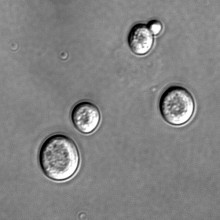
Glycerol diet for long life?
Researchers in the US have discovered that living on a diet made up solely of glycerol could double your lifespan - if you're a yeast, that is.
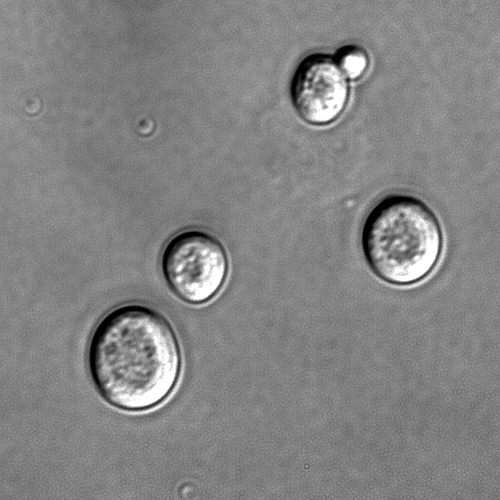 Previous studies have found that severely restricting calories can also double the lifespan of yeast, but in this new research, published in the journal PloS Genetics, Valter Longo and his team have found a more filling alternative.
Previous studies have found that severely restricting calories can also double the lifespan of yeast, but in this new research, published in the journal PloS Genetics, Valter Longo and his team have found a more filling alternative.
The scientists tried feeding glycerol to yeast after they discovered that yeast that had been genetically engineered to have a much longer lifespan also showed increased activity of genes that produce glycerol. The yeast also have low activity levels of a molecular pathway known as TOR1/SCH9, which is thought to be important for extending lifespan in many different animals from worms to mice.
At the moment this work only applies to yeast but it is certainly intriguing. Longo suggests that it may be possible to extend even the lifespan of human by changing the makeup of our diet. We know from previous studies that extreme calorie cutting can extend human lifespan, although - who would want to live a life without cake anyway? Perhaps changing the energy sources in the human diet may also have an effect on lifespan.
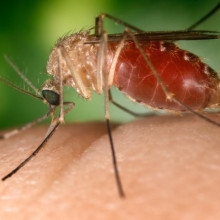
“Good” bacteria block malaria
Mosquitoes are a major problem around the world, not just because they're annoying, but because they spread deadly malaria which kills over a million people worldwide every year, mostly children in Africa.
This week, researchers at Johns Hopkins Bloomberg School of Public Health in the States have made an important discovery that could pave the way for new ways to tackle these pesky insects. Their work is published in the latest edition of PloS Pathogens.
The researchers focused on bacteria found in the gut of Anopheles gambiae mosquitoes, and discovered that the bacteria help to prevent the mosquitoes from becoming infected with the parasite that causes malaria. When mosquitoes were treated with antibiotics to kill their gut bugs, they became much more susceptible to infection with the malaria parasite. The team also found that infection with the bacteria shortened the mosquito's lifespan.
This is good news because it takes about two weeks for the malaria parasite to complete its life cycle within a mosquito host, so if the mossies are dying earlier, as well as being more resistant to infection with the parasite, it means they're less likely to pass on malaria.
The researchers think that the stimulation of the mosquito's immune system caused by the bacteria also helps to block infection by Plasmodium falciparum, the malaria parasite.
Lead author George Dimopoulos suggests that deliberately introducing the bacteria to wild populations of mosquitoes could be a potential way to control malaria infections. He and his team are currently trying to identify which strains of bacteria trigger the strongest mosquito immune defense against the malaria parasite.
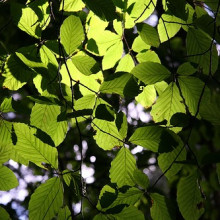
Plant trees. Save electricity.
With all the talk of climate change and trying to cut down our carbon footprint, scientists this week have come up with evidence of a new way to help cut down on electricity bills - the solution may be as simple as planting some trees.
 Two researchers from the States, David Butry of the National Institute of Standards and Technology and Jeffrey Donovan of the U.S. Department of Agriculture, have conducted a study looking at how planting trees around your house can help shade it in summer and reduce the need to switch on air conditioners. We all know that trees provide shade and a nice spot to sit under in the summer but this is the first wide-scale study to investigate whether this can translate into significant energy savings in the home. Butry and Donovan studied 460 homes in Sacramento during the summer of 2007 - they looked at what trees were growing around the house and then linked this to the energy bills of each household.
Two researchers from the States, David Butry of the National Institute of Standards and Technology and Jeffrey Donovan of the U.S. Department of Agriculture, have conducted a study looking at how planting trees around your house can help shade it in summer and reduce the need to switch on air conditioners. We all know that trees provide shade and a nice spot to sit under in the summer but this is the first wide-scale study to investigate whether this can translate into significant energy savings in the home. Butry and Donovan studied 460 homes in Sacramento during the summer of 2007 - they looked at what trees were growing around the house and then linked this to the energy bills of each household.
They found that planting trees on the west and south sides of the house decreased summer electricity use, by an average of 5% a year, while trees on the north side of houses actually increased the use of electricity and those on the east had no effect. Fast-growing trees work better than smaller, slower growing species. They worked out that a London Plane tree planted on the west side of a house could reduce carbon emissions from air conditioners by an average of 30% over 100 years.
And of course trees have the added benefit that they not only shade houses but they absorb and lock away carbon dioxide from the atmosphere too. This study sounds very promising and the authors are keen for researchers in other regions of the world to see if they find a similar pattern.
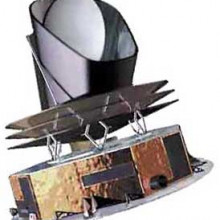
09:46 - Studying Space - The Launch of Planck and Herschel
Studying Space - The Launch of Planck and Herschel
with Dr Anthony Challinor, Institute of Astronomy, Cambridge University
Kat - Thursday 14th May, all being well, we are going to see the launch of the European Space Agency's Herschel and Planck missions which are studying the formation of stars and galaxies and background radiation, all sorts of exciting things.
On the show today we are joined by Dr. Anthony Challinor who is here to tell us about the mission and how he is going to be looking at some of the data from it. So thanks coming on the show Anthony.
Anthony - That's quite alright.
Kat - So tell me what is the mission that you are involved in and what is it doing?
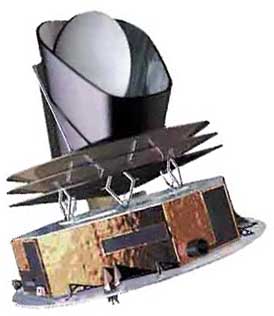 Anthony - So we are involved in the Planck mission and what Planck is trying to do is study what's called the cosmic microwave background radiation. So this is really the oldest light in the universe. It was essentially created in the big bang itself and what we are going to try and do is study very sensitively the tiny variations in temperature in this radiation when you look in different directions and from that we have to learn a lot about both the early universe and also something about what the universe is composed of, what its geometry is and perhaps even the ultimate fate of the universe.
Anthony - So we are involved in the Planck mission and what Planck is trying to do is study what's called the cosmic microwave background radiation. So this is really the oldest light in the universe. It was essentially created in the big bang itself and what we are going to try and do is study very sensitively the tiny variations in temperature in this radiation when you look in different directions and from that we have to learn a lot about both the early universe and also something about what the universe is composed of, what its geometry is and perhaps even the ultimate fate of the universe.
Kat - Crikey. What's the actual satellite going to be like? Where is it shooting off to?
Anthony - Planck, its ultimate home is going to be what's called the second Langrange point which is a very special point about one and half million kilometres from the Earth and it is peculiar in that it rotates at exactly the same angular speed about the Sun as the Earth does. So thermally it's a very stable environment which is exactly what you need when you are looking for these tiny temperature variations - just about a millionth of a degree fluctuations we are looking for.
Kat - And so you are looking for these tiny fluctuations in temperature, how far back in time are you hoping to be able to look, you know you are hoping that this data will shed light on?
Anthony - So the cosmic microwave background radiation was produced very, very early in the history of the universe and the early universe is very, very opaque but eventually it became essentially transparent about 400,000 years after when we think the big bang occurred and at that time the microwave background effectively decoupled from all the matter in the universe.
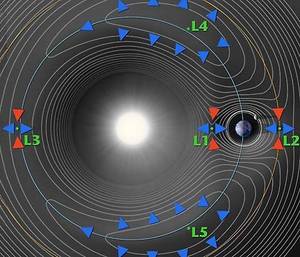 So when we look at it today, we are effectively seeing a snapshot of conditions in the universe 400,000 years after the big bang or about 13 billion years, 14 billion years back in time from now.
So when we look at it today, we are effectively seeing a snapshot of conditions in the universe 400,000 years after the big bang or about 13 billion years, 14 billion years back in time from now.
Kat - And how is the Planck mission special or different from the sort of previous microwave measuring experiments that have been there before?
Anthony - Well so Planck is Europe's first satellite mission to try and measure the microwave background. There have been two other NASA missions before, the first called KOBE, the second called WMAP which is actually still observing.
Planck is an improvement in that it is much more sensitive. It will observe very, very much wider range of wavelengths and it has better angular resolution as well.
Kat - And if it is so far away from the Earth how is it sending the signals all the way back for you to analyse back in the lab? How long does it take that data to get to you?
Anthony - Well the data is transmitted, it is not transmitted continuously but it's sort of buffered on board and then there's an hour or two-hours' slot everyday when it is all transmitted back.
Kat - And how long does it take to get back to you?
Anthony - What from the...
Kat - Yeah, from the satellite.
Anthony - It takes, it is 1.5 million kilometres so however long light takes to travel that distance.
Kat - I don't know, any of our listeners would like to do that calculation and tell us, that will be great. Tell us a little bit about Herschel, the other satellite as well, what's that up to?
 Anthony - Okay, so we are not directly involved in Herschel although there are groups in the U.K. that are and what Herschel is basically trying to do is it is looking at dust within the universe.
Anthony - Okay, so we are not directly involved in Herschel although there are groups in the U.K. that are and what Herschel is basically trying to do is it is looking at dust within the universe.
So it is an infrared satellite and it is basically looking at galaxies that otherwise we can not see in optical light because that the star light is sort of shrouded and absorbed by dust. But that dust is then heated by the star light and re-radiates in the infrared. So Herschel will be able to see those sorts of environments directly.
Kat - I love the idea of a satellite going out looking for dust out to the universe and doing the dusting, "How Clean is Your Galaxy?"
Anthony - Some people are very interested in dust, yeah.
Kat - Some people are. So where is the mission launching from this Thursday?
Anthony - So it's going to launch from Kourou in French Guiana.
Kat - And you didn't manage to get a ticket out there?
Anthony - Unfortunately no.
Kat - And when are the first, the first bits of information going to be coming back? How long is it going to take to get into position?
Anthony - So it takes about three months for Planck to reach L-2 where it will start observing from and the plan then, it takes a couple of months further to sort of settle down and properly be commissioned but after that Planck will do basically two complete surveys of the sky, which will take about 15 months.
Kat - And then you get all the data back and come back on the show and tell us all about it.
Anthony - That's right, I mean we get the data back essentially as soon as Planck starts observing but it will be probably about three years before there is any real public data release of the cosmological data.
Kat - Brilliant, well we will really look forward to hearing that. Thank you very much. That's Dr. Anthony Challinor from the Institute of Astronomy here in Cambridge. So if you are a space-excited person then watch out for the launch of the satellite this Thursday.
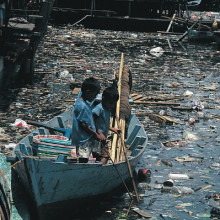
20:07 - The Great Cam Cleanup
The Great Cam Cleanup
with Luther Phillips, Camboaters, and Andrew Walters, RiverCare
Kat - One factor that has a significant impact on the quality of rivers is human activity. Tonnes of rubbish is just chucked into rivers and canals every year and this not only makes the rivers look pretty dirty, it also does threaten wildlife.
Now here in Cambridge the Great Cam Cleanup is a volunteer project to help keep the river clean and Ben Valsler went along to help out.
Ben - I have spent this morning alongside many other volunteers pulling rubbish out of the River Cam and out of the banks of the River Cam. This had been part of the Great Cam Cleanup, now in its fifth year: an opportunity for volunteers from the community to get together and try and clean up their waterways and their green spaces.
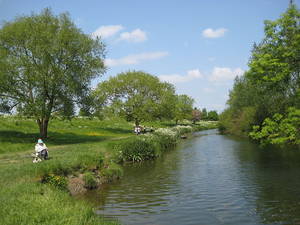 I am here with Luther Phillips who organised this year's Great Cam Cleanup and also with Andrew Walters from Anglian Water's RiverCare project. So Luther, why have you organised the Great Cam Cleanup?
I am here with Luther Phillips who organised this year's Great Cam Cleanup and also with Andrew Walters from Anglian Water's RiverCare project. So Luther, why have you organised the Great Cam Cleanup?
Luther - Because I care about the river Cam. I live on the river Cam and I really do have a passion for the wildlife in Cambridge. I live on Stourbridge Common and it is not far from the centre of Cambridge, but on a daily basis I see herons, I see grebes; I see kingfishers, the cows grazing on the Common.
The rubbish that we generate, if we can just be conscious of the fact that we generate rubbish and if we are in a position that we can actually recycle that rubbish, it will create an environment where we enjoy our green spaces and our river more and more.
Ben - And it's not just the wildlife, is it? I know a great deal of people walk their dogs, people cycle along that route and the fact that it is cleaner in itself makes it more enjoyable for people.
Luther - There are many different river users that obviously use the river: they're rowers, they're dog walkers, there is a residential boating community, anglers and obviously everyone has a vested interest in keeping the river clean but the fact that there are so many different walks of life that use the river. It is important that we can bring these people together in an event like this to help them to be able to take care of it, to maintain and to sustain what we created today and in particular, we want to create a legacy that once people see that, you know the next few days of, the open spaces will be clean; the river will be clean in their consciousness and they'll think well actually we can sustain this.
So it is a very important event that will create a legacy in people's minds as something that they can sustain.
Ben - Alongside us today I think I have seen at least three generations of people helping to pick up rubbish and to keep the river clean. How many people do actually get involved in this?
Luther - We have had over 225 people who registered in advance for the event. Today we have over 185 signatures and there were people who just came along, took part and disappeared without even just making their presence known. So I would estimate there's over 200 people that physically took part today.
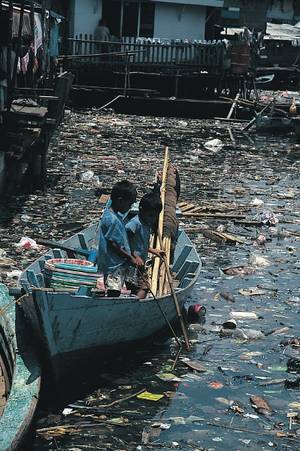 Ben - And between 200 people it actually makes cleaning this stretch of the river, seem relatively light work but how much rubbish did you pull out?
Ben - And between 200 people it actually makes cleaning this stretch of the river, seem relatively light work but how much rubbish did you pull out?
Luther - Well that's difficult to estimate because at this stage we have just concluded the event. However, I must say that it is increased on the number of bags that we collected last year. There were over 660 bags of recyclable rubbish last year, 100 and something bikes which were pulled out of the river. There were a vast number of trolleys.
So it's a fantastic effort by the people of Cambridge who have just spent their time, they sacrificed six-seven hours of the day and they have given something back to Cambridge which is very important. It has created a more cohesive community and it's empowered people because they are more passionate and they will go away from today and they will talk to their friends, they will talk to their colleagues at work on Monday and I am sure, next year this event which will be on 27th of March, 2010 will be even bigger than it was today.
Ben - I am also joined by Andrew Walters from the Anglian Water RiverCare project. Andrew, you must be extremely pleased to see volunteers coming out in such huge numbers to try and keep the rivers clean.
Andrew - It is great. It has been a really great day to have such local people concerned about their local environment. I mean the river here, the Cam, it is a green wildlife corridor really running through the city and so to have this many people out there, just taking real hands-on practical action to clean it up is really encouraging.
Ben - So do we know for a fact that removing rubbish from inside and around a river is actually good to keep it greener, to keep it cleaner, to encourage the wildlife here?
Andrew - Yeah we do, I mean directly, without being too gruesome, we know that when unfortunately otters are killed on roads and autopsies are performed, a lot of rubbish is found within their guts so it is genuinely polluting the environment and it is a danger to wildlife as well.
More indirectly, I think when people see a river and the riverbanks that are clean and free of litter they are more inspired by them and more encouraged to respect them and they have a sense of ownership of them and really appreciate them as the kind of the urban habitats that they are.
Ben - So what is it that you at RiverCare actually do?
 Andrew - RiverCare, our role really is to support communities around the Eastern region to set up local groups which do just this, they are practically working on the local rivers, removing rubbish, removing litter and also doing surveys of the wildlife that is there.
Andrew - RiverCare, our role really is to support communities around the Eastern region to set up local groups which do just this, they are practically working on the local rivers, removing rubbish, removing litter and also doing surveys of the wildlife that is there.
Ben - So it is not just clearing up rubbish then, it's not literally a rubbish removal project. You also have wildlife surveys and I assume you deal with the invasive species that we have.
Andrew - That's right. I mean it's a two-fold thing really. Firstly, the groups do great work in logging where certain invasive species are occurring but also in the instance of Himalayan Balsam which is an invasive weed that's becoming more prevalent on our riverbanks, in midsummer when it is just coming up the groups do lot of work in removing it from the riverbanks which enables the native wild flowers to grow and prevent some bank erosion during the winter.
Ben - And the wildlife surveys, the bio-diversity surveys that you run, is there anything particularly exciting we could see around here?
Andrew - I think there is, I mean I think an issue is that often when we see a bike or shopping trolley, or some litter in our local river, we think that it's probably in a poor state but the reality is actually that the biodiversity within the rivers and on the banks is very rich and the rivers are generally in good quality around Cambridge and so don't be put-off when you see an odd bit of litter around.
Ben - What should people do if they live near a river and want to get involved with making it a happier, healthier place to be?
Andrew - If you are interested in getting involved then please do take a look at our website which is www.rivercare.org.uk, have a look on there and see if there is a local group in your area and join them in doing this kind of thing.
Ben - And of course one essential thing is just not to drop litter in the first place.
Andrew - Absolutely, it's great to have days like these today with people picking up all this huge amounts of litter but then of course the great way to start is just by not dropping it in the first place.
Kat - And that was Andrew Walters from RiverCare and before him Luther Phillips who organises the Great Cam Cleanup. They were both talking to our producer Ben Valsler about the importance of cleaning up the river for both the wildlife and the local community.
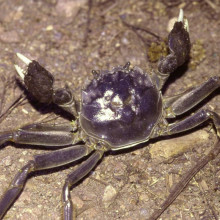
27:47 - Invasive Alien Species
Invasive Alien Species
with Dr David Aldridge, Cambridge University
Helen - Well, in the studio now we have Dr David Aldridge from Cambridge University and he works on the understanding how the ecology of invasive species affects our rivers and fresh waters and finds out ways of trying to stop them. Hi David, thanks for coming in to the studio.
David - Hello Helen. It is a great pleasure to be here.
Helen - Fantastic. Well first of all, what do we really mean by invasive species and why are they a problem?
David - Most people understand the term 'invasive species' to relate to species which are not native in a new area but which also have a negative impact on the ecosystem.
Helen - So we can have invaders that we don't notice or they generally stand out, we know that they are there and that's why they are a problem?
David - We sometimes talked about this 'Tens Rule' that about ten per cent of the species which invade a new system don't establish and then only ten per cent of those that do establish actually have a measurable impact so there's lots of things around in our rivers and elsewhere and in our environment which we don't really notice and don't really have a measurable impact.
Helen - And the things that get to the British waterways and are a problem, what sort of things, are we are seeing arriving in our shores?
David - Well we have just finished an inventory of all the non-native species in Britain's waterways and we have...
Helen - How many are all there?
David - There's about 120.
Helen - Well, okay.
David - But there's lots waiting to come and we are trying to help predict which is going to be the next big problem but some of the really big problems throughout the U.K. at present in the Cambridge area...
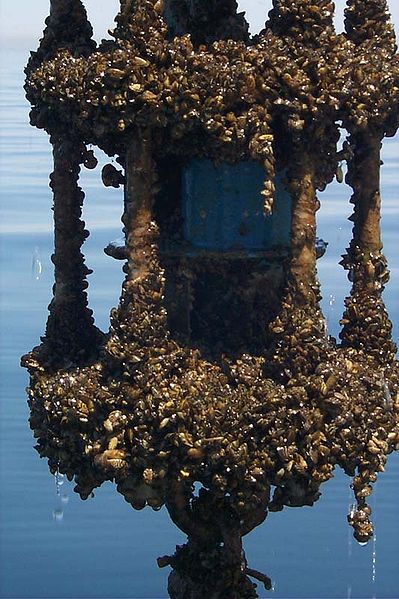 Helen - You've got something in front of you there I see. You've brought some dead critters I am pleased to say, into the studios. Well what have you got there?
Helen - You've got something in front of you there I see. You've brought some dead critters I am pleased to say, into the studios. Well what have you got there?
David - I have got a little menagerie of goodies here and I have got some zebra mussels, I have got a signal crayfish of North America and I have got a Chinese mitten crab.
Helen - Excellent, we heard a little bit about the zebra mussels last time you were on the show a couple of years ago and I take it they are still a problem very much within the U.K. waters.
David - They have become an increasingly larger problem and actually they have got a very close relative, something which belongs to the same genus, something called the Quagga mussel which is building up in the river Rhine and almost displacing the zebra mussels and so that's going to arrive with us very soon.
Helen - So another invasion of something that's getting rid of another invasion, and why are they a problem? What's wrong with having these zebra mussels? They look rather beautiful I have to say. The collection you've got right there, the stripey and you know, they don't look problematic. They look quite small and sort of size of thumbnail, I mean why should that be a problem in the wild?
David - You are right they are beautiful but unlike our native fresh water mussels which just sit in the bottom of rivers with their foot digging into the mud zebra mussels have a beard, a byssal thread which is like the marine mussels that you eat.
Helen - Moules Mariniere, tasty, lovely...
David - Indeed. So zebra mussels are able to sit on solid surfaces and they can attach to each other and sit in dense layers so they can foul pipelines and drinking water supplies, cooling systems to power plants, irrigation systems but also they sit on our native wildlife and one of the things they really threaten such as this specimen I have got in front of me, are our native mussels which provide a really good substrate and they choke them and cause them to die.
Helen - Because that's a huge mussel you've there and I can hardly see it, it's kind of covered in smaller zebra mussels, that's incredible. And then the crayfish you've got there, that looks quite tasty. Can we eat those?
David - We can and that's the reason they were brought over here. The American Signal crayfish was brought over in the 1970s as a commercial aquaculture food and the problem with these crayfish is that they can walk over land so they escaped out of these little ponds they were put in and they can move into the wider environment.
So they are very good at sort of changing the ecosystem through feeding on the bottom rooting plants and macrophytes and they dig burrows which can cause destabilisation of the banks but perhaps of greatest or immediate concern is that they carry a fungus, something called crayfish plague which kills our native crayfish species but these are pretty resistant and the American ones are pretty resistant too.
So we have had for instance in the Cam in 2000 there was an outbreak of plague which wiped out native crayfish from about 20 kms of river within weeks.
Helen - Wow, and could we kind of combat that fungus? Is that one way of looking at sort of the problem or do we really just need to get rid of the invasive crayfish themselves?
David - The Signal crayfish and the other non-native crayfish we have in Britain are a real problem. Nobody has really found a way of controlling those. The environment agency have tried sort of heavy duty trapping, people tried pheromone traps to try and skew the sex ratio in the rivers.
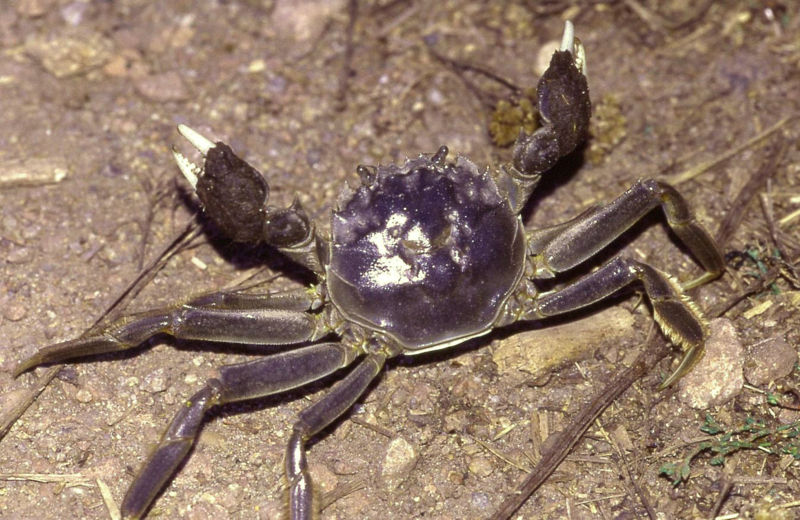 One of my sort of observations is that certainly in sort of some of the chalk streams the river Shep, for instance in Cambridgeshire where you have got cooler headwaters the fungus seems to be less virulent there and so they could be refuges for the native crayfish in those areas but generally speaking there's no known way to eradicate this.
One of my sort of observations is that certainly in sort of some of the chalk streams the river Shep, for instance in Cambridgeshire where you have got cooler headwaters the fungus seems to be less virulent there and so they could be refuges for the native crayfish in those areas but generally speaking there's no known way to eradicate this.
Helen - So far we don't know what to do about them and you have got another crab in front of you and you said that was a Chinese Mitten crab, did they come from China?
David - Yes, and quite a few of our non-native species have come from China. They are very popular food items in Asia and the Chinese mitten crab is quite tasty but unfortunately in China it also carries a fluke which is harmful to humans.
Helen - So that's like burrow into a liver or something.
David - That's right, yeah. The things that flukes usually do.
Helen - Nasty things, okay. But you also work in China. You are looking at similar sort of issues and invasive species out there?
David - Yeah, I have been working in China for the last five years with the World Bank and there the focus is on sort of trying to rehabilitate some of the world's largest but most polluted freshwater ecosystems. So I am working on the border with Tibet in some of the China's largest lakes that were created during the Himalayan uplift and...
Helen - How big is the lake?
David - Lake Dianchi, which is the largest one we work in, is about 300 square kilometres. The second largest one we have lake Fuxian, which is 160 metres deep. They are pretty big things.
Helen - Pretty huge then, yeah. So there's a lot of space there for lots of creatures to get into?
David - Yeah, I mean historically these lakes we have discovered had massive endemism. We have found in the areas sort of 50 species of fish which you find in these lakes and nowhere else but with habitat degradation we are discovering these ecosystems have really crashed. Over 90% of the biomass in these lakes are non-native organisms, things like introduced Carp, the water hyacinth which totally smothers the lake surfaces.
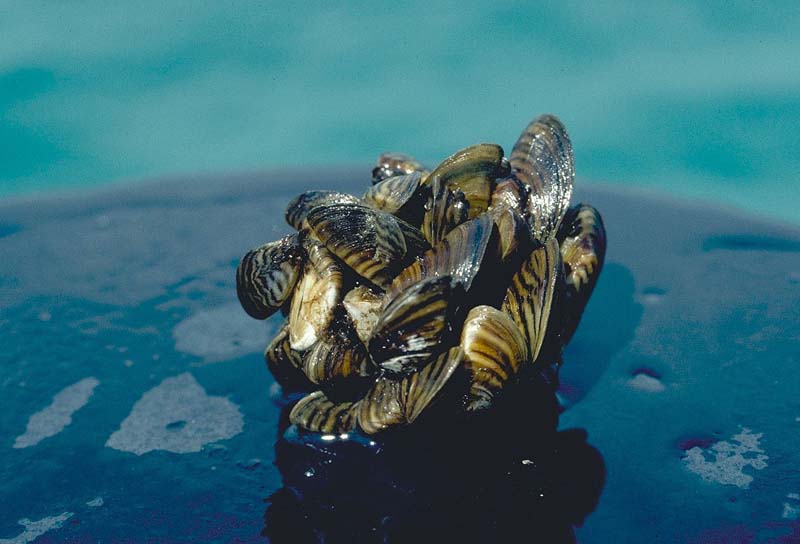 Helen - So only ten per cent of the living stuff in those lakes is stuff that should be there really.
Helen - So only ten per cent of the living stuff in those lakes is stuff that should be there really.
David - Yeah, and actually a lot of the stuff that hasn't been described before, the fish have been well studied but when I went out the first time five years ago I put a dry suit on and jumped in to the water which a lot of Chinese people tend not to do. I rolled over some rocks and I found a new species of leech, a huge thing with green and purple stripes...
Helen - Oh gosh, that sounds horrible.
David - All sorts of things, yeah.
Helen - So amazing creatures there.
David - Yeah, absolutely.
Helen - And finally really what can we do to try and protect ecosystems from these invaders? It sounds like there's an enormous problem in China, how on Earth can you start to actually do anything about that?
David - A lot of it is education but the problem is that until we understand and we can conduct risk analyses and identify what invaders are going to be the most likely next big problems. It is very difficult to develop policy and decide what we should be doing to stop things moving around. We have to understand the vectors, there is implication for climate change on this and whether a new species might be better suited to invading things. So all sorts of complicated issues to consider.
Helen - It sounds like a very thorny issue indeed but thank you very much for coming and introducing us to the world of invasive species. That was David Aldridge. He is from Cambridge University and works on understanding the aliens that are invading our waterways.
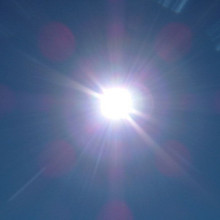
Is the Sun Alive?
We put this to Kat Arney...
Kat - No it isn't. It is a big flaming ball of exploding helium or hydrogen, one of the two. Physics not my strong point but no, it is not alive. It is not cells in it.
We also put this to Dave Ansell, for whom physics is a strong point! To think about this question we really need a definition of life, whilst it is obvious that a cat is alive at a first glance it is less obvious that lichen is alive, you would only notice if you look at it for a period of years.
There are various properties that we associate with living things.
Metabolism - converting energy from one form to another. Normally with living creatures this is light or chemical energy being converted into other forms, but there is no fundamental reason life shouldn't be powered by nuclear fusion like the sun. Homeostasis - the regulation of an internal environment, eg your body maintains its temperature by sweating, but simple creatures will regulate the chemistry in their cell. If the sun gets too hot it will expand, slowing down the nuclear reactions that power it and cooling it down so it could be said to do this.
Response to stimuli - if you metaphorically poke almost all living things they will react in some way. Some creatures will react directly to being actually poked, but even single cell creatures will react to sunlight, or food. - I guess a star will alter if you apply a large enough stimulus, but not in a way very like a living creature.
Reproduction - this is a really important one, all living things can reproduce themselves and in the process they normally have to grow. - I can't think of any way in which the sun could reproduce. Conceivably large stars that go supernova trigger the formation of other stars, but this falls down on:
Inheritance - When a living thing reproduces, the children inherit features from their parents, such as the colour of eyes, shape of foot, the ability to make an enzyme which interferes with penicillin etc. And critically this inheritance isn't quite perfect - it is liable to mutation - so the creature can evolve.
Even if you could say that a star can reproduce by going supernova the created stars do not inherit features from the star which went bang, and although a star does appear to metabolise hydrogen to form helium I don't think that you could say that a star is alive.
Saying that, the surface star is a hugely complex thing with interactions between plasmas, nuclear fusion and magnetic fields It is conceivable that there is some form of life, entirely unlike creatures on earth, and we may not recognise it even if we were looking straight at it. But at the moment this is well into the realms of science fiction.
Could mosquito gut bugs protect humans?
We put this to Kat Arney:
Kat - It is an interesting question. I think this works to a very early stage. The protection from the bacteria for the mosquitoes is really due to their immune system rather than anything special about the bacteria themselves as far as I know at the moment. So it's certainly an interesting question and I don't think it would work if it infected humans with bacteria either but certainly an interesting question, thanks Keith.
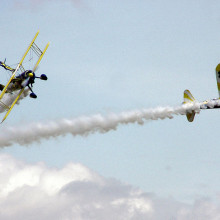
44:36 - Can you do a loop-the-loop in a passenger jet?
Can you do a loop-the-loop in a passenger jet?
We put this firstly to Disk Schleh, of Boeing Commercial Airplanes in Seattle, Washington:
Well a large passenger jet such as the Boeing 747 or almost, almost any large passenger jetliner was not designed nor was it tested, nor was it certified to perform aerobatic manoeuvres like a loop-the-loop or a barrel roll.
Certainly the wings of the airplane would be put under quite a bit of stress and some of the tail structure and so forth, doesn't mean it couldn't do it but they were not designed that way and they were certainly not certified with that in mind. In the early days of the jetliners when the jetliner was being developed at the Boeing company in the 1950s there was a prototype called the 367-80, that was the 707 prototype and the original test pilot on that airplane was Tex Johnston and one day he was asked to fly the aeroplane over a major event here in Seattle which was called the Hydroplane Races, so he did in fact fly the aeroplane at a fairly low altitude over the crowd but then he decided to really impress the crowd so he did a barrel roll with that airplane, much to the surprise of the Boeing officials who were watching from down below.
But he felt that it was a good demonstration of the aeroplane's capability but he was strongly reminded never to do that again and indeed, as far as I know, it has not been done again at least certainly not as part of our test operation here at Boeing.
We then asked Peter Merton, Resident Research Officer at the Imperial War Museum at Duxford. The simple answer is frankly, no. The critical points about, well not just modern passenger jet airliners but airliners built in the past during the 20s and 30s coming forward in time is that they are designed to be load carriers. So they are designed to withstand the quite severe adverse weather conditions, to be able to carry passengers and cargo in safety and especially now-a-days of course with the long-range jets to carry a lot of fuel.
So they are perfectly capable of some quite violent manoeuvres in terms of things like steep turns and I have seen them being flown with a very graceful positional flying, doing quite steep dives and climbs but not of course with passengers or cargo on board. This is the big difference that they are designed to be strong and robust and particularly to have a good survivability factor in case of an accident or a crash landing whereas the purpose designed aerobatic aircraft or even other aircraft types like fighter aircraft, can cope with the stresses and that is the critical difference really.









Comments
Add a comment